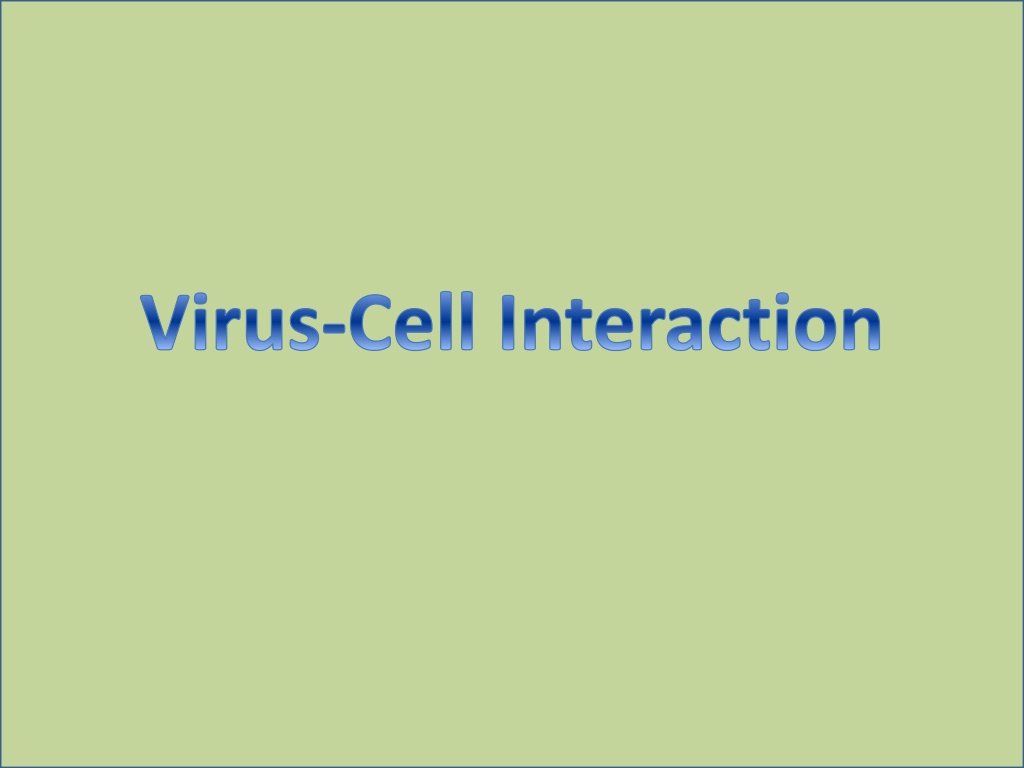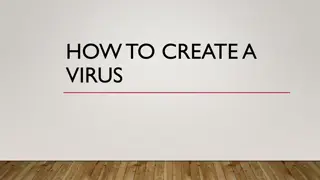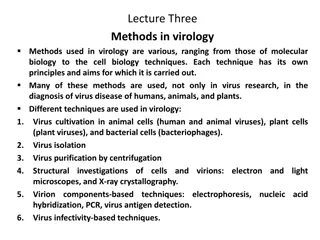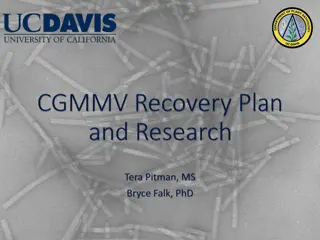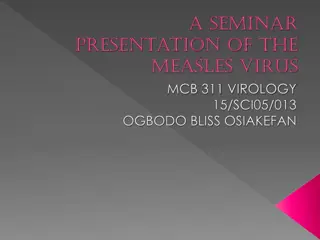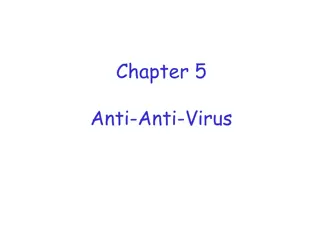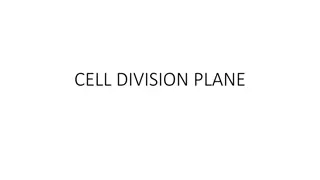Understanding Virus-Cell Interactions: Mechanisms and Consequences
Viruses interact with host cells in various ways, encoding genes that manipulate cell functions for their benefit. These interactions can range from benign to lethal outcomes. Factors influencing these interactions include viral factors, cellular responses, and the presence of virulence factors. Different types of interactions such as cytocidal and non-cytocidal interactions affect cell behavior and can lead to cytopathic effects. Mechanisms of cell damage caused by viruses involve inhibition of nucleic acid synthesis, RNA transcription, and protein synthesis. These interactions result in cytopathic changes affecting cell physiology and metabolism.
Download Presentation

Please find below an Image/Link to download the presentation.
The content on the website is provided AS IS for your information and personal use only. It may not be sold, licensed, or shared on other websites without obtaining consent from the author. Download presentation by click this link. If you encounter any issues during the download, it is possible that the publisher has removed the file from their server.
E N D
Presentation Transcript
Viruses often encode genes that induce, mimic, or shut down host cell functions for their own benefit Host has elaborate systems to shut down viral functions. The outcome of infection may vary from essentially benign and undetectable, to tolerated, to lethal.
Viral Factor Cellular factor Physiologic, immune, or inflammatory responses of the host Expression of virulence factors by the virus
Types of Virus-Cell Interactions CYTOCIDAL NONCYTOCIDAL PRODUCTIVE NON-PRODUCTIVE PERMISSIVE NON-PERMISSIVE
Cytocidal Changes in Virus-Infected Cells Viruses kill the cells in which they replicate. The resulting cell damage is known as a cytopathic effect (CPE). Cytopathic effect is often characteristic of the particular virus involved and is therefore an important preliminary clue in the dentification of clinical isolates
Mechanisms of Cell Damage Inhibition of host cell nucleic acid synthesis -depletion of machinery of DNA replication -produce a DNase that degrades cellular DNA DNA Inhibition of host cell RNA transcription and processing -decreases in the availability of transcription factors required for RNA polymerase activity -Virus encoded factors modulate the expression of cellular genes RNA Inhibition of host cell protein synthesis -production of viral enzymes that degrade cellular mRNAs, -production of factors that bind to ribosomes and inhibit cellular mRNA - -alteration of the intracellular ionic environment favoring the translation of viral mRNAs over cellular mRNAs. Protein
Cytopathic Changes A. Effects on cell Physiology changes in cellular metabolism alteration in the ATP synthetic pathways deviation in the ion channel system
Cytopathic Changes B. Effects on cell morphology Cell Membrane Fusion and production of syncytia -Syncytia is multinucleated cells result from the fusion of an infected cell with neighboring infected or uninfected cells -fusion bridges may allow viral entities to spread while escaping the effects of host defenses -fusion is mediated by viral fusion proteins Eg. the fusion activity of influenza viruses is carried on hemagglutinin peplomers (spikes), whereas the fusion activity of many paramyxoviruses, is carried on separate peplomers composed of fusion (F) protein.
Cytopathic Changes Involving the Cytoskeleton - The cytoskeleton is responsible for the structural integrity of the cell, for the transport of organelles through the cell, and for certain cell motility activities. virus infected cells exhibit changes in cell shape caused by damage to the cytoskeleton (actin, vimentin and tubulin)
Hemadsorption and Hemagglutination -virus belonging to family orthomyxoviruses, paramyxoviruses, and togaviruses bud from the plasma membrane -during budding process they incorporate viral glycoprotein peplomers into the plasma membrane of infected cells - viral glycoprotein serve as receptors for ligands on the surface of erythrocytes
Noncytocidal Changes Noncytocidal viruses cause persistent infection, in which infected cells produce and release virions but overall cellular metabolism is little affected. - regulatory and homeostatic functions of endocrine organs - digestive and metabolic functions of exocrine organs - locomotor and circulatory functions of muscles
Inclusion Bodies formation of inclusion bodies is a characteristic morphological change in cells infected by certain viruses intranuclear or intracytoplasmic single or multiple, large or small, round or irregular in shape, acidophilic or basophilic
Inclusion bodies Intracytoplasmic Intranuclear
Intracytoplasmic Negri Bodies in Rabies Guarnieri bodies in small pox Intranuclear Acidophillic: Vericella zooster, Herpes Simplex, Yellow Fever virus Basophilic: Adenovirus, Cytomegalovirus Both Intracytoplasmic and Intranuclear Canine distemper virus
Nature of Inclusion Bodies Accumulations of viral components: eg. Negri bodies (Rabies) are masses of viral nucleocapsids Sites intracytoplasmic inclusions found in cells infected with poxviruses of viral synthesis (viroplasm): eg. Crystalline aggregates of virions: eg. adenovirus inclusions in the nucleus and reovirus inclusions in the cytoplasm of infected cell
Ultrastructural Changes in Virus-Infected Cells Increased synthesis of nuclear membranes: eg herpesviruses Proliferation of the endoplasmic reticulum: flaviviruses Proliferation of vesicles in the cytoplasm: picornaviruses and caliciviruses Fusions of cytoplasmic membranes: eg retroviruses Disruption of cytoskeletal elements Mitochondrial damage Changes in the density of the cytosol
Viral infection: establishment of the antiviral state
Viral interference When a virus-infected cell resists superinfection with the same or a different virus Interferon mediated Viral interference Defective interfering mutant
Interferons Isaacs and Lindenmann (1957) Cells of the CAM of embryonated hen's eggs infected with influenza virus release into the medium a nonviral protein, "interferon," Not synthesized by cells constitutively, but secreted transiently in response viral infections
Definition of Interferons Naturally occurring proteins Secreted by eukaryotic cells in response to virus infection, tumour and other inducers Reacts with uninfected cells so as to render them resistant to infection to virus
EFFECTS OF INTERFERONS IMMUNOLOGIC EFFECTS Cytokines regulate the innate immune system natural killer (NK) cells, macrophages and neutrophils. They also regulate the adaptive immune system, the T and B cell immune responses. EFFECTS ON TUMOR CELLS Increased MHC class I antigen expression Increased expression of tumor-associated antigens Increased expression of adhesion molecules
Nonimmunologic effects Antiangiogenesis effects cytostatic and cytotoxic effects on tumor cells Antimetastatic effects on tumor cells
Virus-Induced Cell Death Apoptosis Necrosis
Role of the immune system against virus attack Natural killer cells and cytotoxic T cells are the major type of immune cells involved against virus infection in the host. NK cells cause the direct cytotoxicity of the virus infected cells The virus surface antigens are presented over the major histocompatibility antigens class I (MHC-I) molecules and activates the cytotoxic T lymphocytes (CTLs). CTLs exert antiviral state by secreting cytokines and apoptosis.
Viral strategies to escape host immune response Evasion of interferon system by viruses : blocking the different steps involved in the interferon signaling cascade Inhibition of protein synthesis : inhibition of cellular protein synthesis and upregulation of viral protein synthesis Inhibition of interferon production: Many viruses encode dsRNA-binding proteins that inhibit the Many viruses encode dsRNA-binding proteins that inhibit the enzymes protein kinases and 2 -5 oligoadenylate synthetase
Inhibition of interferon signaling :blocks the downstream signaling pathway
